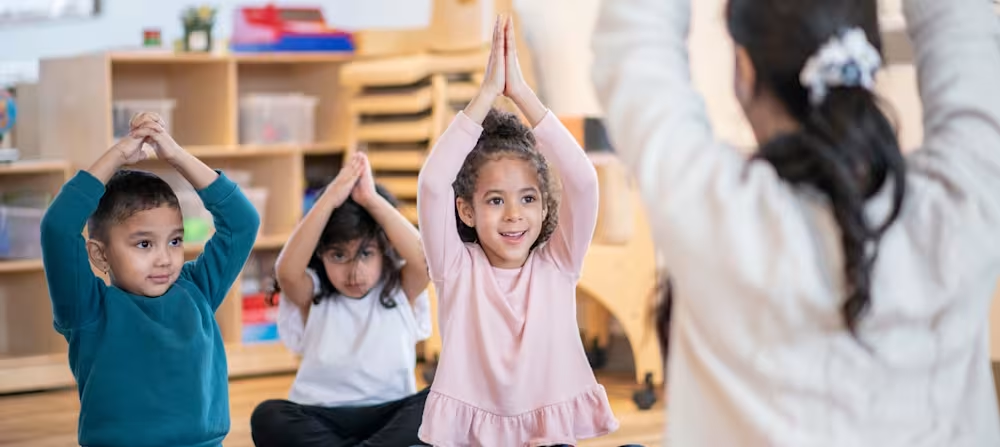Play activities: What is developmentally and age-appropriate?
Updated Aug 14, 2025

Today’s parents are often considered by older generations to be a bit overbearing, or “extra” if you will. Gone are the days when parents shuffle their kiddos out of the door with a “come home before the streetlights come on!” laissez-faire parenting style. Fast forward a generation, advanced technology, and endless access to free information. Parents these days find themselves in a completely different child-rearing world.
With the influx of free and accessible information at our fingertips, there is no shortage of advice regarding what parents should and shouldn’t be doing with their children. This inevitably leads to confusion. And yeah, maybe we can be a little “extra” because society tells us we need to do ALL the things! with our babies in order for them to bond, be kind, reach their milestones, not become serial killers, and get into Harvard… OK, maybe not quite that far.
Not to worry! As an Occupational Therapist and parent, I’ll ease your mind and simplify age and developmentally appropriate activities you can do with your child from the newborn to toddler phases.
Developmentally appropriate activities are tasks that parents do to support their child’s growth, learning, and overall health that match both the child’s current abilities as well as their potential.
Developmentally appropriate activities for infants
0 - 3 months
When your newborn starts to become more aware and their senses begin to become accustomed to their surroundings, you’ll be relieved to know that it doesn’t take much to engage in developmentally appropriate activities.
Examples of simple, great activities include:
Staring at your face (seriously!)
Looking at highly contrasted images (i.e. black and white pictures)
Chatting using high-pitched baby voices (Yes, your MIL’s annoying baby voice is actually engaging!) []
Spending time on the floor
I would be remiss if I didn’t mention that pediatric OTs and PTs recommend spending a few moments in tummy time each day. Tummy time not only provides your baby with ideal sensory input but also gives them the opportunity to strengthen key muscles that they will need to achieve their gross motor milestones []. Most of their motor movements are primitive and reflexive, meaning newborns have minimal control over their bodies [].
helps a baby to feel more comfortable in various positions and to integrate their reflexes. By 2 months, babies usually show signs of the social smile [], which is the first sign of the brain’s attempt to engage in reciprocal communication. It’s that unmistakable, “Did they just smile back at me!?” moment. No fancy toys or products are needed during this stage!
4 - 8 months
Around 4 months of age, babies just start to realize that they have hands! They also start to look around, take in their environment [], and begin to anticipate routines []. If you haven’t already, establish a short but predictable bedtime routine! This can help your baby feel secure as they anticipate what is going to happen.
Developmentally appropriate activities for this age may include playing with a rattle, soft spoon, or any non-choke hazard, giving the opportunity for your baby to reach for and grasp it. Staring at lights and ceiling fans is also quite an engaging activity.
A simple idea for an activity may be putting up string lights in the home for your baby to enjoy while in tummy or floor time. As your baby reaches closer to 6 months, they may prefer to do more activities while in supported or unsupported sitting, and become much more interested in novel activities [].
Be careful though, because your baby will naturally put just about anything in their mouth! More activities for a 6 - 8 month old include (where no fancy toys are necessary):
Playing peek-a-boo
Introducing bubbles
Water play
Banging blocks together
Outdoor nature walks
Reading new picture books
Parents often introduce sign language around this age to help their children communicate simple needs such as “more”, “milk”, and “all done”.
9 - 12 months
Older babies begin to understand that even though they can’t see you, you’re still there! Cue separation anxiety and possible sleep disturbances as your baby will actively seek out your presence more. Babies may signal for you more often than usual []. A great activity for this age is to come and go from the room while your baby is in a safe space, narrating that you are still there and will come back.
As your baby learns to master crawling, standing, and even taking steps, some activities to try include:
Playing in the grass or on different textured surfaces
Using the bucket swing on the playground
Making faces in the mirror
Tummy time floor play
Playing with kitchen utensils including pots and pans
Enjoying nursery rhymes that include clapping and dancing
Developmentally appropriate activities for toddlers
Toddlers (1 - 2 years old)
Pretend play begins to emerge, first with self and then with others []. Your child also becomes more independent at this age but will check in with you often in order to feel secure about venturing out and exploring [].
Try not to worry if your toddler keeps a death grip on their toys when other kids are around. Your child does not solidly understand the concept of sharing or rules and boundaries at this age, so expecting altruistic behavior while playing with peers is not realistic. Side-by-side play with peers is more typical playtime behavior versus reciprocal playtime where there is sharing and cooperation.
In addition, at this age, expressive communication becomes a skill that your child will practice and master over the next few years. Some activities to foster a toddler’s development include: spending time reading the same book or two, as research shows that reading the same books over and over boosts vocabulary []!
Also, providing more freedom to do the following are stimulating and helps a child start to develop emotional intelligence:
Play independently
Engage in imaginary play such as pretending to put stuffed animals to bed (which can also help prepare toddlers for their own )
Hands-on activities including water play, board puzzles with knobs
Practicing putting on hats, socks, and other simple dressing tasks
Developmentally appropriate activities for preschoolers
Preschoolers (3 - 4 years old)
The focus for preschoolers is learning to engage in cooperative play. The best way for preschoolers to learn this skill is to observe through modeling. Demonstrating how to comfort someone who is hurt reinforces cooperative behavior as well as playing games that require turn-taking (such as Go Fish).
You can also begin to introduce simple chores for your child to help them feel involved in the family structure. Examples include:
Asking your child to help make lunch
Encouraging your child to pick up their toys and place them in a toy bin
Asking to put their clothes in the laundry bin
As a child nears 4 years old, their self-identity outside of the family unit develops, so it is very important for kids to socialize with peers []. Playdates that provide ample opportunity for your child to learn how to resolve conflict and make friends are ideal for this age group!
Activity Tracking feature in the Huckleberry app
If you’re prone to information overwhelm or feel stuck in a rut when at home with your child, Huckleberry has created a great app to make you feel more organized and accomplished when going through your day-to-day activities with your little one.
Use our new in the Huckleberry app to give yourself and other caregivers a snapshot of the day! For example, say you’ve clocked 10 minutes of tummy time with your 5 week old. It may not seem significant at the moment, but logging that developmentally appropriate activity will help you feel more accomplished.
Developmentally appropriate activities FAQ
Share article:
Note: The content on this site is for informational purposes only and should not replace medical advice from your doctor, pediatrician, or medical professional. If you have questions or concerns, you should contact a medical professional.









